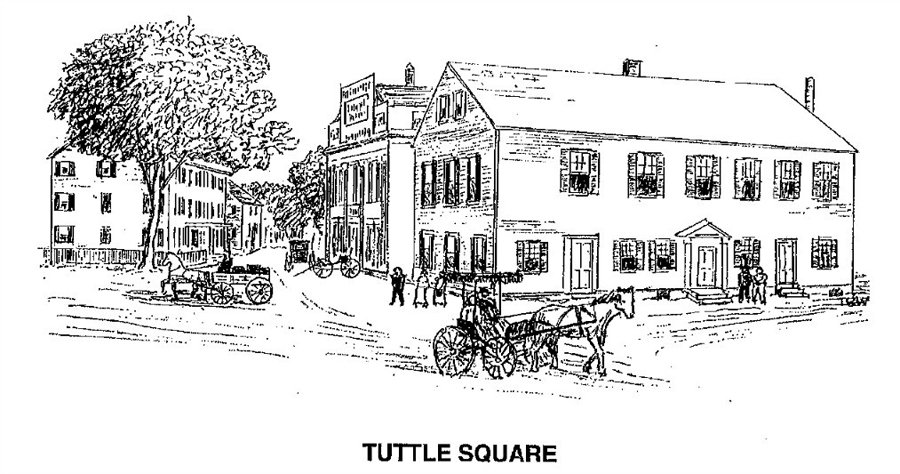Disclaimer
The Dover Public Library website offers public access to a wide range of information, including historical materials that are products of their particular times, and may contain values, language or stereotypes that would now be deemed insensitive, inappropriate or factually inaccurate. However, these records reflect the shared attitudes and values of the community from which they were collected and thus constitute an important social record.
The materials contained in the collection do not represent the opinions of the City of Dover, or the Dover Public Library.
2000 Heritage Walking Tour
Heritage Walking Tour Booklet October 2000 by the Dover Heritage Group, Dover, NH, c. 2000.
In 1978, a group called Dover Tomorrow formed to promote the growth and prosperity of Dover. A subcommittee was tasked with promoting “appreciation of Dover’s heritage”. The Lively City Committee created the first Heritage Walk the next year. It was so popular that new tours were created every year, and held through 2007. By 1982, Dover’s historical society, the Northam Colonists, had taken over the research and creation of the Heritage Walking Tour Booklets. The information on the page below is a transcription of the original Heritage Walking Tour Booklet. The Library has a complete set of the Heritage Walking Tours if you would like to see the original booklets.
The sketch above is looking across the Square from the front of First Parish Church sometime in the 1800s. On the left you see the Dover Hotel (where Century 21 Realtors is today) with the Pendexter-Varney house behind it. Across Hanson Street from the Hotel is Bellevue Hall behind the Courthouse (where the Mobil Service Station is today).
The first settlers arrived at Dover Point in 1623. Ten years later a second (and larger) group arrived and they started moving north up Dover Neck. By about 1700 some settlers were at “The Corner”, now known as Tuttle Square. It was called “The Corner” because it was the junction of the road to Cochecho and the road to Barrington (later called Silver Street). This was the center of activity for the town for most of the eighteenth century. Some of the oldest houses that still exist in Dover are near this corner, including #17 Silver Street which is the oldest building still being used for a residence in Dover.
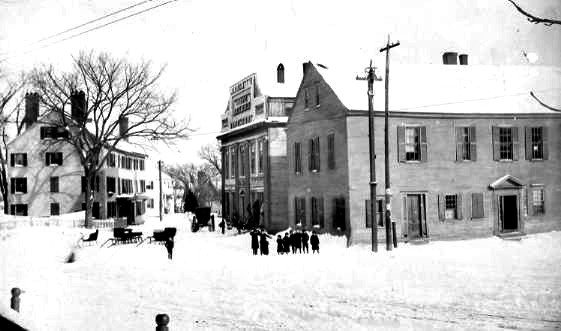
The easiest way to get from “The Corner” to Portsmouth in the eighteenth century was to go down the path (about where Hanson Street is today) to the river and row your boat to Portsmouth.
Later the area became know as Tuttle Square. It was named for Tobias Tuttle, a Revolutionary War veteran, who bought eleven acres of land here in 1795. He later built the Tuttle Block on the southerly side of Silver Street, where Christina Otis Baker had formerly maintained an inn.
In 1882 public transportation came to Tuttle Square when the Dover Horse Railway commenced operating from Sawyer Mills to Garrison Hill. Later in 1901 after the line had become an electric railroad, a loop was put in that went up Silver Street, over Arch Street, and down Washington. The electric railroad, known as the Dover, Somersworth and Rochester Street Railway, ceased operation in 1926.
Christine Otis Baker’s Tavern (No photo available. Now an empty lot.)
During the Cochecho Massacre of 1689, blacksmith Richard Otis was killed by the Indians along with two of his eleven children. His wife, Grizel, and two other children and three grandchildren were taken as captives by the Abenaki and marched to Quebec where the French government would pay the Indians a substantial bounty for delivering English prisoners. One of these children was 3-month old Margaret Otis. Upon her safe arrival in Montreal, Margaret was re-christened as Christine and raised by nuns in an Ursuline convent. In 1707, at age 18, Christine married Louis LeBeau and had three children with him (incl. one who died in infancy). LeBeau died in 1713 and Christine was a widow at age 24.
In 1714, Deerfield, Massachusetts resident Capt. Thomas Baker was sent on a mission to Canada to negotiate with the French for the return of some 150 English captives. There, in Montreal, he met and fell in love with Christine. The governor of New France would not allow Christine to leave as she was a naturalized citizen and property holder. So six months later, Christine snuck away with Baker, leaving her two daughters, her aged mother, and her household belongings behind so she could return to New England.
Christine had been granted 500 acres of land in York County, Maine which se sold in order to buy land and build a home in her native Dover. In 1735, at age 46, she was granted a license to operate a tavern at the corner of Silver and Central Streets. Thomas was in poor health by this time and Christine ran the business on her own. Her next door neighbor and minister, Dr. Jeremy Belknap praised Christine as “a pattern of industry, prudence, and economy.” The Royal Governor, Benning Wentworth, always visited Christine’s establishment for “the reputation of her repasts” and the “good cheer” he found there. The tavern was reported to be “trim, tidy and efficient.”
By 1790, the site of the tavern had become Toppan’s Variety Store. One account says that the building was then “moved off” and another one constructed here. By the early 1800s, it was called Perkins Block, owned by hardware store owner Jeremy Perkins until circa 1883. Then the building became John E. Kennedy’s Saloon until about 1909. In the twentieth century, the building was the site of the Wentworth Apartments. The structure burned in a fire in the summer of 1968.
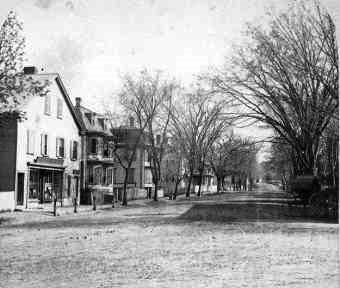
There was an old wooden building on this site that was built around 1790. Before 1830 this building became the home of a drug store operated by John H. Wheeler. Around 1847 Mr. Wheeler brought his son James H. Wheeler into the business and it became known as J.H. Wheeler & Son. When John Wheeler died in 1867, his son James, who had managed in the meantime to become a physician, took over the business. The address of the business was 1 Pleasant Street.
By 1878 James Wheeler had given up the drug store and only had his doctor’s office in this building. The drug store was taken over by George Varneywho operated from this location for about seven years. After Pleasant Street became part of Central Avenue, this location became 201 and 203 Central Avenue.
In 1887, A.T. Pinkam and Company, a drug store, commenced operation. Dr. James H. Wheeler died in 1893 and in 1894 the Pinkham Drug store moved across the street to 208 Central Avenue. After Mr. Pinkham moved out, this building became the home of a bakery operated by Mr. Fred Ramsdell. He was only there about two years and the business was taken over by Homer E. Harfford, and couple more years and George H. Varney was here. This George Varney was in the bakery business, and was here for about twelve years. Around 1912, this location became the home of a Grocery and Bakery business operated by Martin and Addie Whitehouse.
After the Whitehouses retired, this building became Bill’s Lunch for about twenty years. The last know use of this building was as an upholstery shop in the early sixties. The building was removed around 1970.
17/19 Silver Street (Old Inn/Freeman House)
The Inn was built in 1708 by Col. James Calef when Silver Street was called the Barrington Road and was only a cart track; old records speak of a flower garden in front of this house. Now it is the only house out of line with the street, as its granite threshold is directly on the sidewalk. Besides serving as an inn, this home has also been a school, a rooming house, and the location for several businesses. Daniel Webster stopped here when he was a young lawyer and argued a case at the court house. Its old clapboards are covered by shingles, but its architecture is still similar to the old Jackson House in Portsmouth. At one time, the father, mother, and sister of minister and historian Jeremy Belknap lived here. Excepting the Damm Garrison, it is the oldest structure in Dover. Currently house apartments, it is the oldest building in the City which is still inhabited.
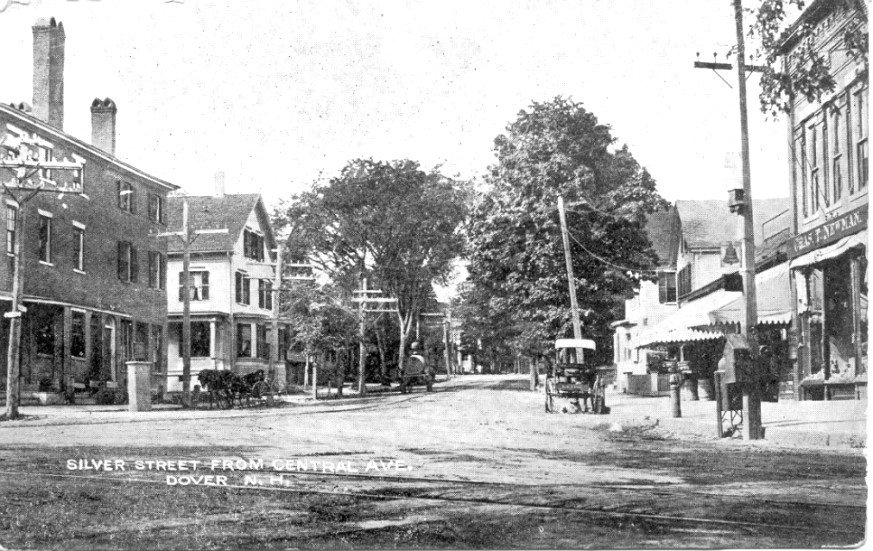
Drug Store Building (1-5 Silver Street)
This property was originally two properties. One was known as 208 Central Avenue and the other known as 1 Silver Street. In 1881 Henry Law bought the building at 1 Silver Street, which was a one storey wooden building, housing the Hanson grocery store. The store had been there about forty years at the time and was run by Nathaniel E. Hanson. The store was originally owned by Nathaniel’s father, John T. Hanson.
In 1885, Henry Law also purchased the building at 208 Central Avenue, a two story brick building to the east of the Hanson store. In 1894, the Pinkham Drug store moved from 203 Central Avenue across the street to 208 Central Avenue. The Pinkham Drug store operated from this location until 1906 when Alonzo T. Pinkham, then the mayor of Dover, dropped dead in his store. After Mr. Pinkham’s death, Mr. Charles T. Newman, who had run a drug store in Franklin Square for a number of years, moved to this location. Mr. Newman died in 1913, but Newman’s pharmacy continued to do business at this location until 1987 with Arthur W. Brown, Joseph A. McCann, Glenn Robinson, and Daniel Kelleher as successive proprietors.
Mr. Law also gained control of the Christie House, which was then 5 Silver Street (now changed to 9 Silver Street), and another building between the drug store building and First Parish Church. Mr. Law continued to make improvements to the Hanson Street property, eventually connecting it to the drug store. At the time of Mr. Law’s death in 1938, a project was underway to make both properties into one two story building with three storefronts. At that time the occupants of the storefronts were: #1 – Newman’s Pharmacy, #2 – Bert Head, a grocer and #3 – New Hampshire League of Arts and Crafts, a gift shop. A couple of years later the Silver Street Market, with Albert Fillion as proprietor, replaced Bert Head and Armand Lord, a barber, replaced the gift shop.
Mr. Law left the building (now 1,3,5 Silver Street) to his neighbor Mrs. Ella S Qualey, who moved into the apartment over unit #1 and lived there until the 1960’s. Glenn Robinson, the proprietor of Newman’s Drug Store at the time, bought the building from the Qualey Family in 1970. In 1992 it was purchased by the First Parish Church.
First Parish Church (218 Central Avenue)
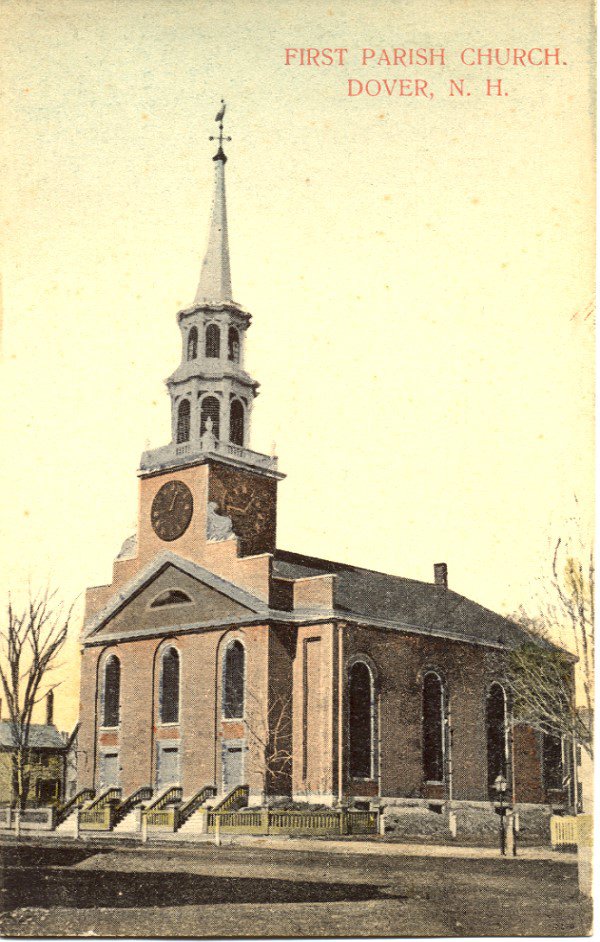
This fifth home of the First Parish Church was dedicated on December 31, 1829.
Its steeple measures 146 feet high and its 150-pound rooster weathervane measures five feet across. The tower clock, first in Dover, installed on May 1, 1835 and was constructed in Boscawen by Benjamin Morrill for $300.
The First Parish Church was founded in 1633 and its first meetinghouse was built in 1634 at Dover Point, somewhere in the vicinity of the current Spaulding Turnpike tollbooth. As the congregation grew a second meetinghouse, 40’ by 26”, was constructed in 1654, fortified in 1667, and used until about 1710. Its spot is still marked along Dover Point Road where the earthworks of the fort can still be seen. As the populace of Dover expanded slowly northward toward the village of Cochecho, a third meetinghouse was erected at Pine Hill, circa 1710. Both houses were used for about a decade, but finally in 1720 all services were permanently transferred to the Pine Hill. The bell from the second meetinghouse was brought to Pine Hill and hung on a frame as the third church had no belfry. (This bell was used until 1913.) In 1731, members of the congregation established a cemetery on the site, Pine Hill Cemetery, which is still used today.
The fourth First Parish Church was built in 1758 at Tuttle Square. It was a two-story wooden structure with a steeple, facing south at a right angle to the present church façade. It served the congregation for the next seventy years until the next population surge in the 1820s when the Cocheco Mills were established and the size of Dover doubled in a decade. Also in 1827, a portion of the First Parish Church’s congregation, avowing a more liberal doctrine than the fundamentalist minister of that time espoused, split off to form the Unitarian Society. The Unitarians built a new church in Dover the next year in a “style attractive and novel” which no doubt added to the First Parish members’ desire for a more modern structure as well. The fourth First Parish Church was called “insufficient and distasteful” in 1824 and a portion of it was sold to Samuel Woodman for $175. Woodman moved it to 32-34 Court Street where it stands today. The fourth church was demolished beginning on March 30, 1820 and for the remainder of that year services were held in the Court House across the street.
The present church continued improvements and innovations through the next century. In 1888, the parish house was built on the site of the old Belknap School and the former vestry building was sold. In 1946, the church’s side balconies were removed and a new altar designed. Once again the church was rededicated on November 24, 1946. During the mid 1950’s, Memorial Hall and numerous class rooms were constructed in the church’s basement and dedicated on September 26, 1956. The home at 208-210 Central Avenue was torn down in 1961 to make room for a church parking lot and the stained glass windows were replaced with white glass windows for a more colonial appearance. The church was placed on the National Register of Historic Places in 1982.
DOVER’S FIRST COURTHOUSE (Now Mobil Gas Station)
In 1783 the town voted to procure land for building a county courthouse. In March 1789 the state granted $300 for erection of a courthouse by November of that year.
Captain Richard Tripe, a well-know carpenter and ship builder contracted to build the courthouse. Upon completion of the building it was discovered that Captain Tripe had charged for work not in the original specifications and the town refused payment for the additional work. A lawsuit ensued to settle claims against the town.
The town and the county were joint owners and occupants of the building. The first town meeting was held on November 23, 1789. The court room was on the second floor while the first floor was used for a jury room and county offices. Daniel Webster was among the famous lawyers addressing juries here. In 1792 Dover was the Capitol of New Hampshire for one year and the state legislature met here in June.
The “old courthouse” was sold in 1845 to Judge Woodman for tenements, however, he retained a small hall on the second floor for private parties. Judge Woodman also turned the building 90 degrees so that the entrance was on Central Ave, rather than Court Street. Eventually the building was removed and the lot became the current Mobil gas station.
Bellevue Hall
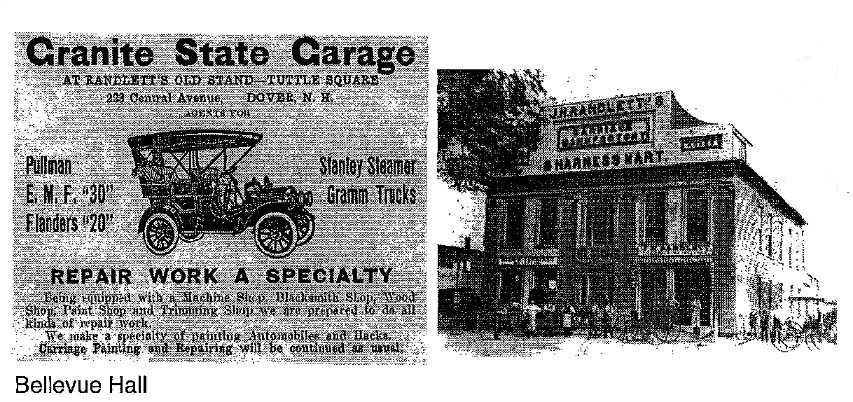
Around 1860 the structure was converted for shops of various sorts, and in 1866 it was remodeled for the manufacture of carriages. A Mr. Joseph H. Randlett came to Dover and opened a carriage business on Locust Street in 1864. Soon he needed more space and the Hall was available, so in 1866 it became Randlett’s Carriage Manufactory and Harness Mart. He continued there until about 1900, employing up to thirty highly skilled mechanics and producing excellent carriages.
As the city moved into the twentieth century carriages and sleighs gave way to newfangled machines called automobiles. Mr. Randlett retired and the building became the Granite State Garage. Although autos were now sold and repaired there, Mr. Randlett’s reputation apparently lingered on because in an advertisement for the Garage in 1912 it stated that it was “AT RANDLETT’S OLD STAND – TUTTLE SQUARE” and that “Carriage Painting and Repairing will be continued as usual.” The old Hall was finally torn down in 1936.
Dover Hotel
Please refer to cover and page 1 for images. It is the first building on the left. It was first an inn in 1773. The Wyatts rented it from Mr. Perkins; they did not own it.
Quotes from: Autobiography of a Landlady of the Old School, 1854, Sophia Hayes Wyatt (1781-1857)
“May 1816, opened Dover hotel, then known as the Gage Tavern; kept it three years; removed to Medford Mass.”
“By the solicitation of gentlemen, we returned to Dover, May 1822. Commenced the second time in the same hotel, with large additions and improvements. It was at the time those factories were commenced, that now cover that large space of ground at the Cochecho Falls.”
“While in that hotel, we were patronized by the first people of the Union. The proprietors of the manufacturing company, with their families, were on the daily list of arrivals, with many others of like distinction.”
“President Monroe and suite made us a formal visit, which amused our good citizens for the time being.”
“In 1825 the great and beloved personage, General Lafayette, visited us, which brought a large concourse of people together; with cheerful countenances and overflowing hearts; each one emulous to be the first to present him the friendly hand, and bid him a hearty welcome.”
The Dover Hotel later became known as Wyatt’s Inn. The Wyatt’s built The NH Hotel across the street from the Dover Hotel in 1827.
“While keeping the Dover Hotel [now owned by Charles Woodman], we built the New Hampshire hotel, one of the most convenient and pleasant house in the state. In 1835, seeing and experiencing the great evils of intemperance, we full decided to make the New Hampshire Hotel a strict temperance house; the first temperance hotel, it will be safe to say, that was established in New England. Some of our customers stood by us, but a larger proportion turned away.”
The Varney – Pendexter House
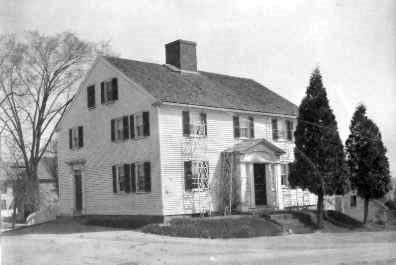
This center chimney house was built around 1740 by Captain Samuel Ham (a sea Captain) on land he purchased from Daniel Titcomb (from the Varney family). Samuel Ham’s wife was Ann Wingate, and her great-aunt, Sarah Wingate, was married to Daniel Titcomb. This was a nice arrangement for both families ensuring that each had good neighbors. In the early 1800’s, the home and land was sold to George Pendexter. George’s granddaughter, Isabella, married John Varney*, thus completing the circle and the Varney-Pendexter family ownership of the house.
*The same John Varney that the Varney school was named after. He died while inspecting the ruins of the Dover Baptist Church (it had burned the night before) – the remains collapsed in on him.
The house has some interesting features. The most prominent feature was the center chimney. This allowed multiple rooms on all the floors to have fireplaces for heating. The house also has floors that slope away from the center to the outside walls. Though historians believe that the slope is due to the outer walls settling (settling of the center is very unlikely due to the construction of the center structure to hold all the brickwork for the chimney and fireplaces). It has also been told that Capt. Varney built it this way on purpose so that he felt more at home on the sloping floor (like that of a sailing vessel). All of the rooms have to go into the hallways. Much of the structure of the house is held together by wooden pegs. This can be especially noticed in the attic where there is no plaster ceiling in place.
St. Mary Academy
In 1826, the New Hampshire Hotel was built on this site. Mrs. Wyatt recalled in her memoirs, “In 1835, seeing and experiencing the great evils of intemperance, we fully decided to make the New Hampshire Hotel a strict temperance house, the first temperance hotel, it will be safe to stay, that was established in New England. Some of our customers stood by us, but a larger proportion turned away.”
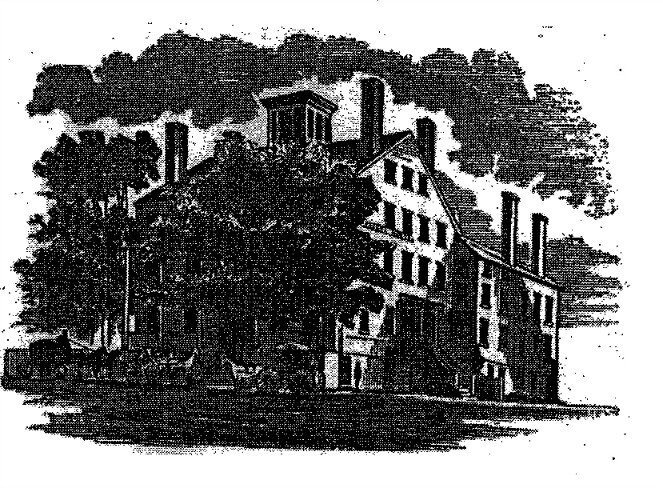
The Hotel was still owned by the Wyatts at least until 1843. By 1846 it had been sold to Levi Shaw, and went through a series of owners, being renamed the New Hampshire House by 1859. In November of 1880, the building was bought by Father Blodgett of St. Mary’s Church, who intended to remodel it into Sacred Heart Convent. Upon his death six months later, he was succeeded by Father Daniel W. Murphy, an Irish immigrant, who carried out Father Blodgett’s plan. Sacred Heart School was built next door, opening in 1883 under a community of Sisters of Mercy from Manchester.

In 1912, the schools of the parish were consolidated in one place with the building of St. Mary’s Academy on the corner of Central Avenue and Church Street. The old convent building was torn down to make way for the Academy. In addition to grammar school grades, it offered two years of high school for boys and three for girls. It evolved into a four-year high school for girls. In 1963, with the building of the co-educational St. Thomas Aquinas High School, St. Mary’s reverted to a grade school. It is now known as St. Mary Academy, serving grades K-8.
Strafford National Bank (Now 9 Angle Street)
Dover’s first bank was granted a charter on June 10, 1803. Original incorporators included William King Atkinson, William Hale, Amos Cogswell, Ezra Green, John Wheeler, Henry Mellen, Daniel Durrell and Oliver Crosby.
All were merchants and attorneys.
A plot of land and buildings were purchased on August 8, 1803 on the east side of the road “leading from Dover Landing to the Meeting House.” Walter Cooper was responsible for the remodeling and supervision of workmen – he oversaw the installation of new locks, vault works, and vault doors. He was paid $192.42 for his efforts. Building supplies cost $526.63 and additional labor (carpenters, locksmiths and masons) cost $404.28. The bank started with $25,870 in startup capitol.
Source: “Out Little Bank Institution” (1803-1978), A history of Strafford National Bank, Dover, New Hampshire, written by Joanne Griffin Domingue.

This historical essay is provided free to all readers as an educational service. It may not be reproduced on any website, list, bulletin board, or in print without the permission of the Dover Public Library. Links to the Dover Public Library homepage or a specific article's URL are permissible.

